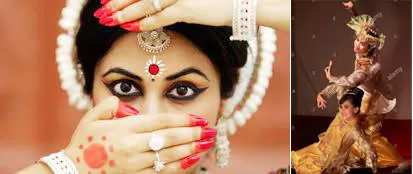“If you want to know about the elements of design or principles of design or proportion in architecture, please click the link”
1) Introduction to Basic Design
- Design, for the purpose of this course should be appreciated as any art form or any artistic activity that results in a creative product.
In Painting

In Sculpture

In Music

In Dance

- Painting, sculpture, music, dance, drama, literature can be seen as the “other‟ creative art forms.
- While anything done creatively, differently, attractively is art: as in the art of walking, talking, living; all these activities are also “designed” to become art forms.
- A day well planned, an attire well chosen, a dining table laid out excitingly are all “designs” and need the elements, principles and objectives of design to be effective.
“Basic” art forms should be understood as art forms “different‟ from architecture, as this art form is also known as the mother of all art forms – By “mother” it is implied that architecture encompasses most art forms in elements and spirit.
2) Architectural Design and ‘other’ design forms
- Architectural design can be seen as an amalgam of the essence of all other design forms and is aptly addressed as “mother of all arts”.
- While other design forms possess the theoretical elements of beauty and strength of expression and the strength of being, architecture needs to be also functional and meaningful for human activities.
- Architecture can thus be seen as organization of space for an expected activity and differs from other art forms because of its extensive utilization and its extensive influence on users.
- The elements of architecture are thus beauty, strength both physical and of expression and beneficial under the overall context of time.
- The nature of Architecture is of Life itself as it addresses the different aspects of living.
- The scope of architecture is limited to the human imagination and in physicality the technology of the time.
- It would also be worth noting that human beings and all art forms survive and grow in architectural creations.



Principles

- Balance is the distribution of the visual weight of objects, colors, texture, and space.
- Emphasis is the part of the design that catches the viewer’s attention.
- Movement is the path the viewer’s eye takes through the work of art, often to focal areas.
- Pattern is the repeating of an object or symbol all over the work of art.
- Repetition works with pattern to make the work of art seem active.
- Proportion is the feeling of unity created when all parts (sizes, amounts, or number) relate well with each other. When drawing the human figure, proportion can refer to the size of the head compared to the rest of the body.
- Rhythm is created when one or more elements of design are used repeatedly to create a feeling of organized movement.
- Variety is the use of several elements of design to hold the viewer’s attention and to guide the viewer’s eye through and around the work of art.
- Unity is the feeling of harmony between all parts of the work of art, which creates a sense of completeness.
Summary
Design can be driven by a variety of goals, such as aesthetics, functionality, sustainability, cost-effectiveness, or a combination of these factors. A good design should be aesthetically pleasing, functional, and efficient, and should consider the impact it will have on its intended users, the environment, and society as a whole.
Architecture is the design and construction of buildings and other physical environments, including the design of interior spaces. It is a multi-disciplinary field that involves creating functional, aesthetically pleasing, and sustainable structures that meet the needs of the people who will use them.